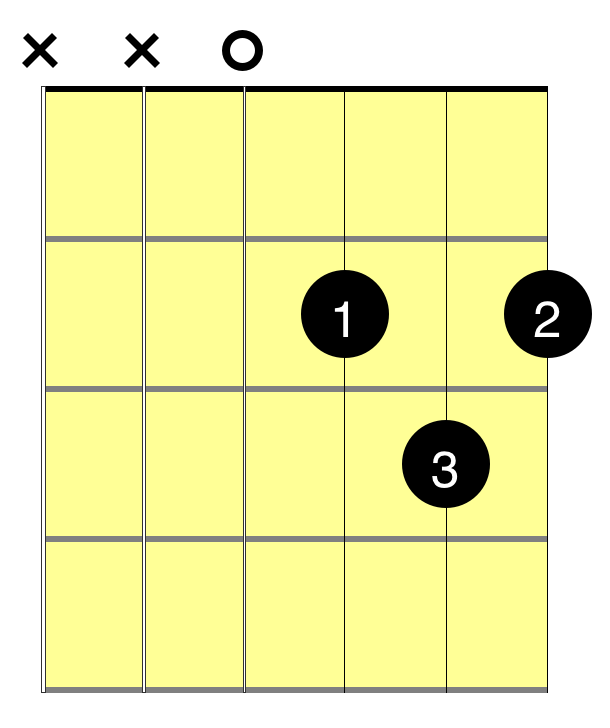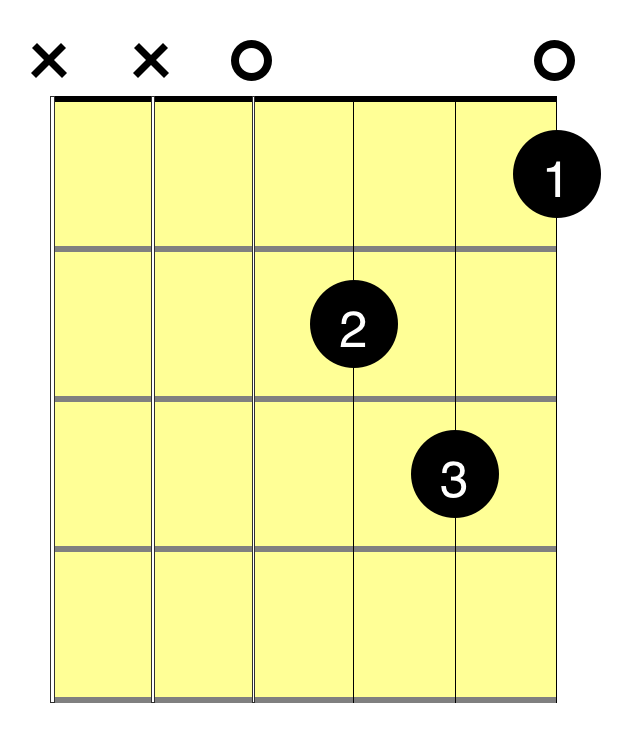The D minor chord is one of those essential beginner chords you should learn early on in your guitar playing career. In terms of difficulty, it’s right in the middle of the pack—not as easy as E minor but nowhere near as hard as F major or B major. As with all minor chords, it’s the same as the major version except that the 3rd note of the scale is lowered one fret. (Don’t worry if you don’t understand what this means yet.) So this means that it’s similar to the D major chord but requires a change in fingering.
(It’s also important to note that, according to Nigel Tufnel, D minor is the saddest of all keys and makes people weep instantly. So there’s that.)
Fingering the D Minor Chord
To play the D minor chord, first make sure your thumb is behind the neck (as described in this lesson). Next, place your middle finger on the 2nd fret of the G string, close to (but not on top of) the 2nd fret. It’s important that you place the finger close to the fret because this will make the next note a lot easier to play because you won’t have to stretch your finger as much.
Now, with your ring finger, play the 3rd fret on the B string. And finally, with your index finger, play the 1st fret of the high E string.
With your right hand, play the top four strings only (D G B E). It’s not a big deal if you occasionally play the fifth string by accident because A is one of the notes in the Dm chord. But you want to avoid hitting the low E string.
Difference Between D Major and D Minor
As you can see, there is only one note that is different between D major and D minor: the F# on the 2nd fret of the E string changes to an F on the 1st fret. But note that, in order to play this, you need to rearrange your fingers as shown; you can’t just finger a D chord and move your 2nd finger down a fret. (Well, maybe you can, but most people’s hands don’t work that way.)
Making It Sound Good
One other thing to note about playing the D minor chord on guitar is that it can be harder to play on cheaper guitars or guitars that aren’t properly set up. This has to do with the string tension on the 1st fret. As you may have noticed, it’s a little harder to fret notes on the 1st fret than it is on most other frets. Because the 1st fret is right next to the nut, the distance from the string to the fretboard can be higher than elsewhere if the guitar is not set up correctly. By “set up correctly”, I mean that the distance from the strings to the frets (the guitar’s “action”) is low enough so that it’s easy to press down, but not so low that the strings buzz. When the action is higher than it should be, this is often most noticeable or problematic on the first fret.
So the point is, if you hear buzzing while you play the D minor chord, check the 1st finger in particular. Make sure it’s pressing the string all the way down to the fret. If it feels hard to do this, check the distance between the string and fret. If it’s too high, you might need to get the action set up on your guitar.
This point about checking the guitar’s action is true for all your playing in general. Before you attempt to play guitar, you need to make sure you have a decent-quality guitar that is properly set up. Trying to play on a cheap or badly setup guitar is extremely frustrating, hard on your fingers, and not fun. Many beginners have given up trying to learn guitar because they had an instrument that was hard to play.
Practice the D Minor Chord
Go ahead and practice the D minor chord so you can add it to your collection of chords. In particular, practice switching between D major and D minor by leaving your 3 finger on the 3rd fret of the B string, and swapping the other two fingers to play each chord shape. Leaving one finger in place like this while other fingers move around is called using a “pivot finger”, and it’s a really useful technique. (When you’re playing actual songs, you won’t often switch from D major to D minor or vice-versa; this is just an exercise to help you practice switching to and from D minor and to introduce the idea of a pivot finger.)
You should also try switching between D minor and other chords, like A minor, G major, C major, E minor…and anything, really.




